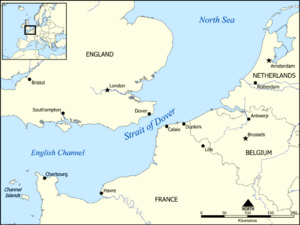Dover Barrage facts for kids
The Dover Barrage was a special underwater barrier built by England. Its main goal was to stop German submarines from using the English Channel during World War I. This barrier was made of explosive mines and special nets called indicator nets. They even used a similar barrier again in World War II.
Contents
The Dover Barrage in World War I
Building the Underwater Wall
When World War I began, England started building this underwater barrier. It stretched between Belgium and Dover, a town in England. First, they laid down many mines, which are like underwater bombs.
In February 1915, they added 25 kilometers (about 15 miles) of indicator nets. These were strong steel nets anchored to the seabed. If a submarine got caught, the nets would move, showing ships on the surface where the submarine was.
How it Worked and What Happened
The first sign that the barrier was working came on March 4, 1915. A German U-boat, called U-8, got caught in the indicator nets. The British were able to capture it.
The first part of the barrier was finished by April 1915. Ships from the Dover patrol kept a close watch over it. Both the British and the Germans thought the barrier was very effective at first. The Germans even blamed some of their submarine losses on it.
However, in March 1916, the Germans discovered a trick. Their submarines could travel across the Channel on the surface at night. This allowed them to get around the underwater barrier.
Improving the Barrier
To fix this, the British moved the barrier. It now covered the area between Folkestone, England, and Cap Gris Nez in France. They also used new, better mines and powerful searchlights. These changes made it much harder for enemy submarines to pass.
By August 1918, the Channel was effectively closed to hostile submarines. Later, underwater scans of the area showed the wreck of a German submarine, SM UB-109. It was broken in half, likely from hitting the barrage.
The Dover Barrage in World War II
A similar mine barrier was also used near Dover during World War II. This happened in 1940, during the Siege of Calais. It helped protect the area during that conflict.


